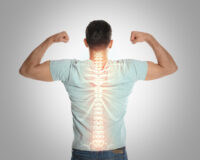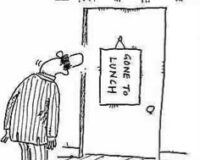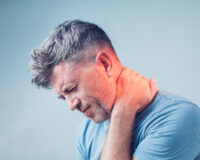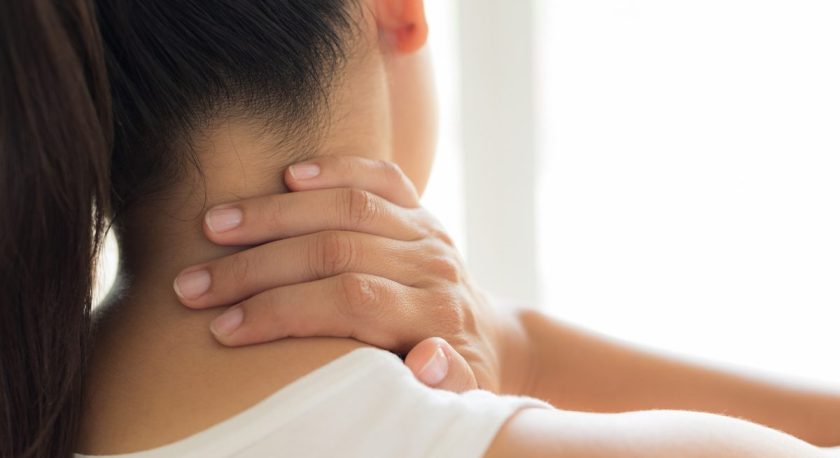
Pain In The Neck & Arm? How Physiotherapy Can Help!
Neck pain is one of the most common injuries in both the sporting and office work population. Around 50% of the population will suffer from neck pain in any year!! Physiotherapists here at our Adelaide based CBD clinic see a lot of this injury! For the purposes of this blog, we are going to delve more into the involvement of the ‘discs’ and ‘nerves’ – in a condition known as cervical radiculopathy.
So what is cervical radiculopathy?
The neck is made up of 7 bones called the cervical vertebrae. Separating each vertebrae is what’s called an intervertebral disc – a cushioning structure which absorbs and distributes load put through the neck.
A canal runs through the vertebral column, which protects the spinal cord. This serves as a main hub for nervous tissue, called the central nervous system (CNS). From the spinal cord, smaller off-shoots (known as nerve roots) arise.
Think of this at the lights in a building; there is the major energy supplier (i.e. the spinal cord) and each room has its own switch that can be turned on or off (i.e. the nerve roots). More specifically, the nerve roots arising from our neck give power and sensation to our neck, shoulders and arms. This is why when these cervical nerve roots become irritated, compressed or damaged, the person may feel symptoms in the shoulders/arms.
In the image below, the yellow represents the nerve roots and the clear structures in-between the bones are your discs.
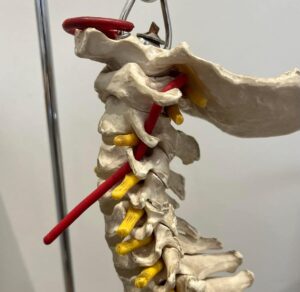
What causes this?
When our discs are subject to prolonged, repetitive or extreme forces such as
- Trauma to the neck playing sports such as football
- Working at a desk for prolonged periods with poor neck posture and minimal breaks
- Repetitively looking down (e.g. at phone or sheets on a bench) over a period of time
This can cause what is known as a disc herniation where the disc can irritate neighbouring nerve roots. Narrowing of the spinal canal (i.e. spinal stenosis) is another cause of nerve related symptoms.
But here’s a fact: Often people will have a disc herniation or age related neck changes, without knowing or experiencing any sort of pain!! In fact, about 50% of people at ~40years will have a disc bulge if scans were to be taken – BUT only very few will experience symptoms. Long story short – scan results do not always predict one’s pain. So remember, this is a common condition that can be fully recovered if managed appropriately
What do people usually report with nerve related neck pain?
The following symptoms may be present in the neck and upper limbs:
- Symptoms may be caused by a specific event or build up over time
- Pain with neck movements, particularly looking up
- Changes in sensation down the arm
- numbness, tingling, pins and needles sensation or the “arm feeling heavy”
- Restricted neck movement
What could make it worse?
- Prolonged sitting at desk with poor neck posture or looking down
- Turning head towards problematic side
- Quick/unguarded neck movements
Diagnosis
Generally a diagnosis can be made in an initial session following the subjective history and physical testing. Scans can be performed if the pain doesn’t relieve in the expected timeframe or if the symptoms are very severe. An MRI may be used.

Common physiotherapy treatments
Education: Advice to stay active/mobile, Conservative use of painkillers (in acute stage, just to manage symptoms), heat pack for neck.
*Treatments to avoid: rest only, strong painkillers, deep massage
Taping/brace: for early stage treatment to assist in pain releif
Manual therapy: Mobilisation movements can be used (once pain settles) to aid in pain relief and range of motion in the short term
Acupuncture: Increase activity and improve blood flow to the local area, promoting neck healing.
Addressing contributing factors: e.g. Assessment of your workstation or working tasks may be important to address the root cause of the issue.
Exercise Prescription: Both mat and equipment based exercise can provide therapeutic benefits for pain and function. Examples of exercises for the acute stage are below..
What exercises can you do in the first 0-2 weeks?
- Neck rotations
- Gentle neck flexion and extension
- Single shoulder rolls
- Deep neck flexor work in supine
DISCLAIMER: please consult with a qualified health professional if you are having any significant pain doing these exercises, or alternatively to progress your exercises as your neck strengthens! We would love to chat over the phone if you have any concerns/questions!
Non-conservative treatment
Injection therapy
Steroid injections may be used for more severe/long-lasting cervical radiculopathies. A surgeon will guide an injection which deposits anti-inflammatory steroids that may ease pain. There are mixed results regarding the outcome of this treatment.
Surgery
There are multiple forms of surgeries to target cervical radiculopathies. Most commonly, these procedures include decompression surgeries, removal of parts of the vertebrae called the laminae and also surgeries that widen the canal where the nerve passes.
Risks apply for both and must be weighed up against the potential gains. A physiotherapist can help to decide on the best treatment.
Key take-home messages
- Nerve related pain in the shoulder/arm can be caused by prolonged poor neck postures or neck trauma.
- Pain/symptoms are generally experienced in the shoulder, down the arm and possibly in the fingers.
- The spine, discs and the surrounding structures are extremely strong in nature and with the correct management/advice, can be managed conservatively
- Physiotherapy treatment including mobilisation, acupuncture, bracing and exercise prescription are all effective in the management of nerve related neck pain
- Surgical treatment could be considered if conservative management is not successful over the first ~6 weeks.
None of the information in this article is a replacement for proper medical advice. Always see a medical professional for advice on your injury.
To know more about neck related nerve pain and to get an assessment, book to see one of our physios through the link below:
Book Appointment
